Today we’ll take a break from digital 3D design and do some good old-fashioned analog knitting. Here’s a stitch we’ve been working with recently, in progress as part of a simple scarf:
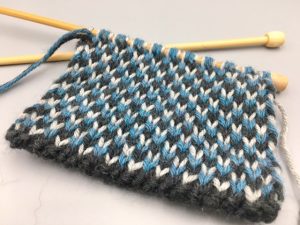
If you think there’s something weird about that stitch, you’re right: If you look across each row you’ll see that… there really aren’t any rows? The stitches kind of zig-zag up and down as you move from one side to the other.
The really cool thing about this stitch is that it is completely reversible, and in fact looks exactly the same on both sides:
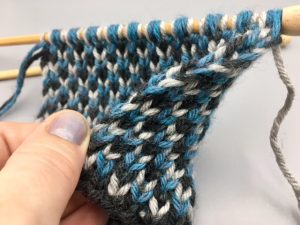
So what is this crazy stitch, and where did it come from? We call it the Triple Check, and it’s a stitch we made up to solve a design problem. Maybe it’s new, maybe it isn’t; we aren’t sure yet, although we haven’t been able to find anything like it on the web or in our knitting books. If you’ve seen this stitch before, please let us know!
Designing by Deduction
Our design problem was to find a simple knit stitch pattern for multicolor reversible scarves that we could knit during math talks and committee meetings. Specifically, we wanted a stitch that would satify all of the following conditions:
- Reversible, preferably identical on each side
- Uses multiple colors but NOT floats, double knitting, or carrying more than one strand of yarn at a time
- Must be a simple stitch with a short repeat that one could easily knit without looking or counting while at a math talk; no brioche or fancy stuff
- Preferably the knitting procedure would be the same on the right side and the wrong side, to avoid confusion/mistakes if knitting while multitasking
- Weaving in ends is tedious, so minimize the need for this
- Finished piece should lie flat and not curl up
Of course the first thing we tried was finding such a stitch in the existing literature; no need to remake the wheel if there are already perfectly good wheels! However, in this case our literature search came up short, so we wondered… could we construct a suitable stitch pattern by deducing certain things from our list of desired conditions?
Somehow we did; here’s how the deduction process panned out:
- One way to satisfy the multiple-colors-one-at-a-time condition (2) is to use slipped stitches. We decided to riff off the slipped-stitches trick for knitting vertical stripes in the round, with each color traveling across the knitting one at a time, slipping stitches to skip over stitches in the opposite color. But in our case we wanted to have a reversible fabric, and to knit on straight needles.
- A really easy way to satisfy the reversibility condition (1) is to use some kind of rib stitch. That would also have the added benefit of satisfying our lay-flat condition (6). We didn’t want something too stretchy so 1×1 rib seemed like a good idea.
- Conditions (3) and (4) basically mean that we have to keep it simple, so we started thinking about the simplest possible way to have a 1×1 rib that slips over other colors. After a bunch of dead ends the most obvious thing ended up working: basically, doing 1×1 rib and then slipping twice to leave a gap for a piece of 1×1 rib in another color.
- The key that made the whole thing come together was using three colors instead of two. With two colors on straight needles, you’d have to knit across and back each row to get back to the other strand of working yarn. But with three colors and straight needles, the parity works out perfectly: knit across with Color A and leave it there, then pick up Color B and knit back on the wrong side, then pick up Color C and knit across, and then pick up Color A from where you left it and bring it back along the wrong side.
- The three-color method above also satisfies condition (5) because there is no need for weaving in ends every time you change colors; all the colors just travel up the sides of the work with no ends.
- When you slip stitches, the carried yarn has to go somewhere. If it goes in front of a knit stitch or if its color peeks through another color, then your work is not going to look good. The final piece of the puzzle was to figure out how to slip stitches so that the carried yarn was hidden inside the work. We’ll show a picture of the method that ended up working after we describe the stitch.
Triple Check Stitch
Here’s the simple, reversible, three-color “Triple Check” stitch that resulted from our deductions:
- In Color A, loosely CO a multiple of 4.
- Pick up Color B and [K1, P1, s1wyib, s1wyif] to end of row.
- Repeat: Pick up Color C and do the same four-stitch pattern for one row. Then pick up Color A and do it again. Then Color B. Then Color C, and so on.
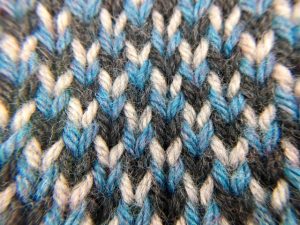
All slipped stitches should be purlwise, whether the yarn is held in back (wyib) or in front (wyif); see the video Slip stitches wyib vs wyif for a demonstration.
Note that in each color we are only traveling along the knitting one time, in one direction; not going across the knitting and back again. At the end of the row just drop the color you are using and pick up the next color, which will be waiting for you.
Hiding the slips
So where is the carried yarn hiding under the slipped stitches? In the close-up image below we’re just done the s1wyif step, slipping a black stitch with the white yarn held in the front:
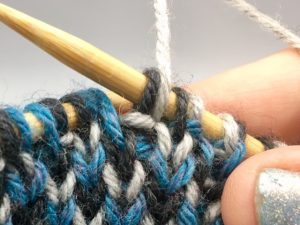
What happens next is that the white “yarn in front” strand needs to be wrapped over the black slipped stitch to the back of the work. Here’s the exciting part: When we wrap the white yarn over the black stitch, the carried yarn will make a white bump that lies exactly over an existing white bump from a previous perl stitch!
Every slipped stitch in the Triple Check pattern wraps over a bump of the same color in this way, either in front or in back of the work. The carried yarn under the slipped stitches is basically copying the “knit, purl” stitch of the 1×1 rib below it (which is luckily of the same color as the carried yarn), but without making any actual stitches. This color-matching on the slipped stitches is the secret sauce of the Triple Check pattern, since all of the slipped stitches end up invisible inside the work.
Triple W Stitch
The Triple W variant below is actually the stitch we discovered first (originally we called it “The W”), but it makes more sense as a variant of the Triple Check. The stitch pattern is pretty much the same as for Triple Check but twice as wide, with pieces of 2×2 rib followed by four slipped stitches.
- In Color A, loosely CO a multiple of 8.
- Pick up Color B and [K1, P1, K1, P1, s1wyib, s1wyif, s1wyib, s1wyif] to end of row.
- Repeat: Pick up Color C and do the same eight-stitch pattern for one row. Then pick up Color A and do it again. Then Color B. Then Color C, and so on.
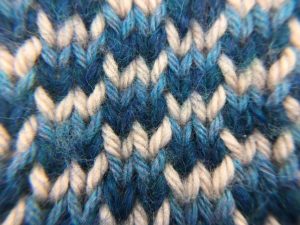
Triple Check and Triple W are good stitches for stash-busting projects that use up your random yarn scraps and leftovers, because you can change colors gradually as you knit. For a gradient/morphing look, change just one of the three colors at a time, leaving two of the colors alone for a while before changing again. Here’s a Triple W scarf-in-progress with a color-morphing rainbow look:
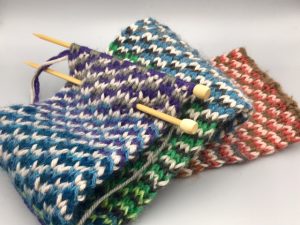
Again, if you’ve seen the Triple Check or the Triple W stitches before, then please let me know! These stitches are so simple that I feel like they have to exist somewhere, but I haven’t been able to find them. Or, maybe we found a piece of low-hanging fruit that everyone else somehow missed, stumbling on that rare combination of easy, interesting, and new? In any case, happy multicolor reversible multitask-knitting :)
UPDATES
- Triple Check is now a project on Ravelry.
- Holly (@antimonia on Twitter) found something by Nancy Marchant that looks just like Triple Check on one side. It’s brioche so much more difficult, and not identically reversible, but the front side matches perfectly!
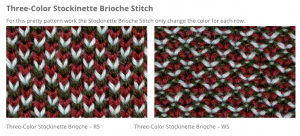
- Another good catch from Holly: You can get a reversible “tiny hearts” stitch by knitting two strands in white and one in red. After a couple of rows I started knitting/perling into the backs of the loops of the red stitches, to make them come to a sharp point and look more like hearts:
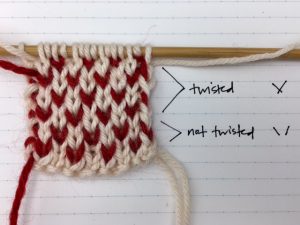
- Trammell Hudson and Rod Bogart did some bind-off experiments and found that K1,P1 is a good bind off for the Triple Check:
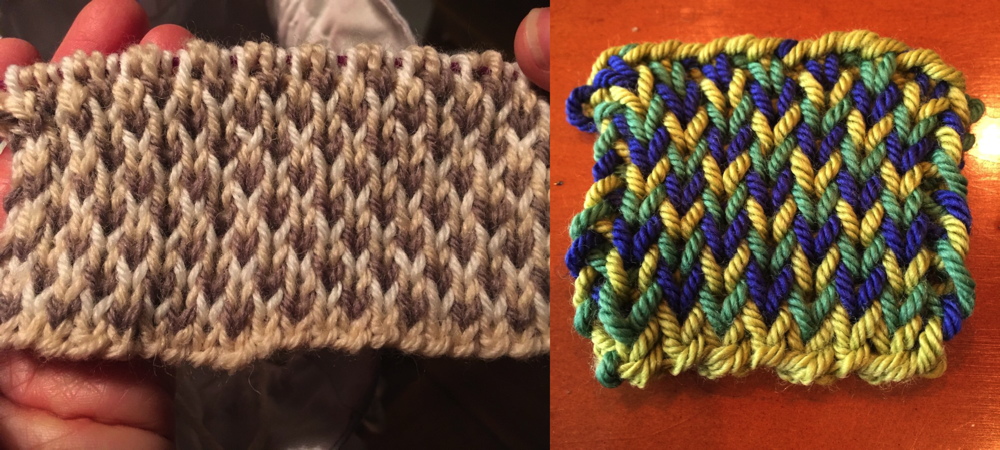
- More samples from Jacqueline Jensen-Vallin and Rod Bogart‘s wife. Love all the different color looks!
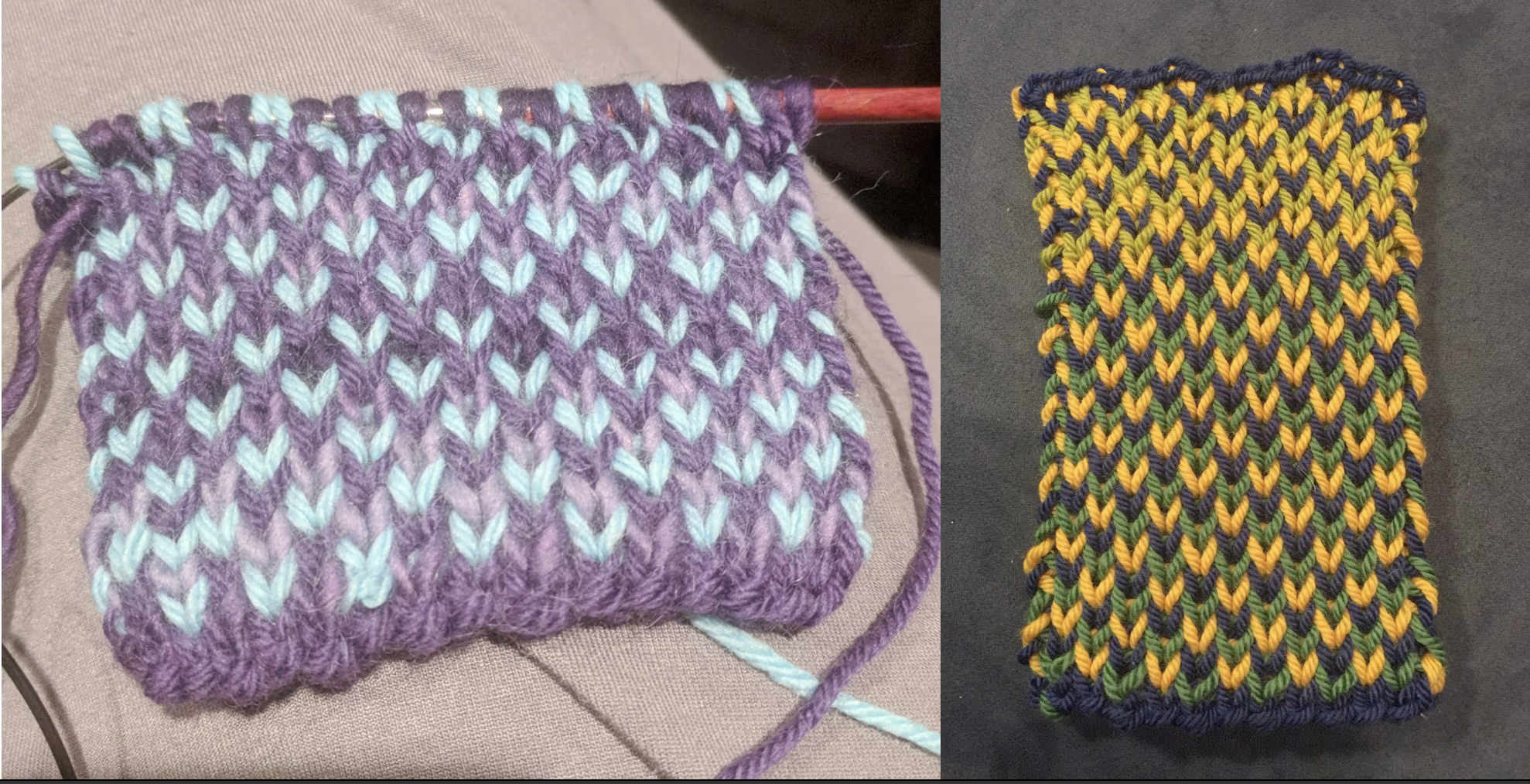
- This design from Ellen Gormley uses a similar three-color staggered-row trick, but with crochet!
TRIPLE CHECK SWEATER! @adrian left this amazing photo in the comments of a beautiful triple check sweater :) :) :)
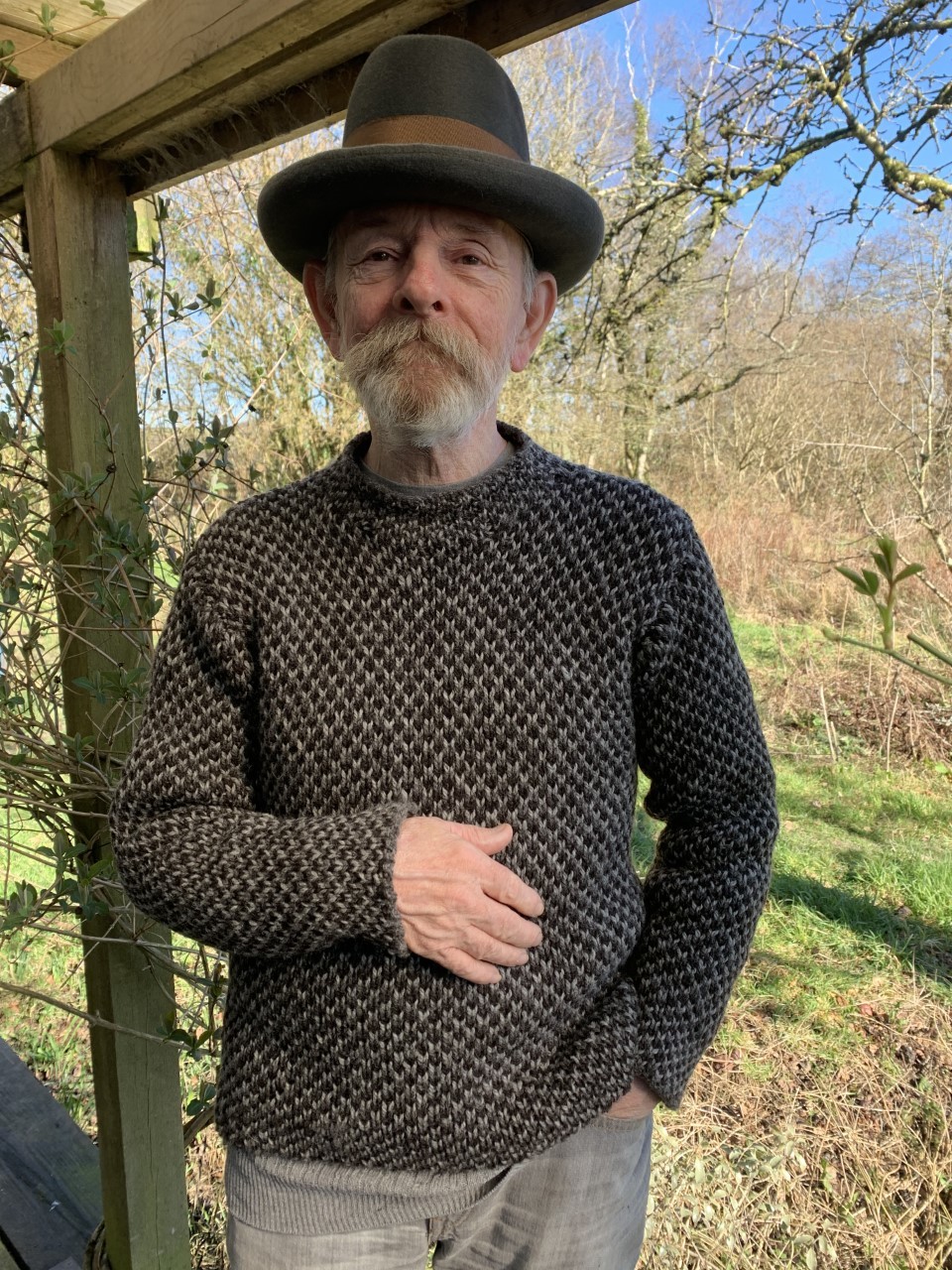
——————
As an Amazon Associate we earn from qualifying purchases, so if you’ve got something you need to pick up anyway, going to Amazon through this link will help us keep Hacktastic running. Thanks! :)

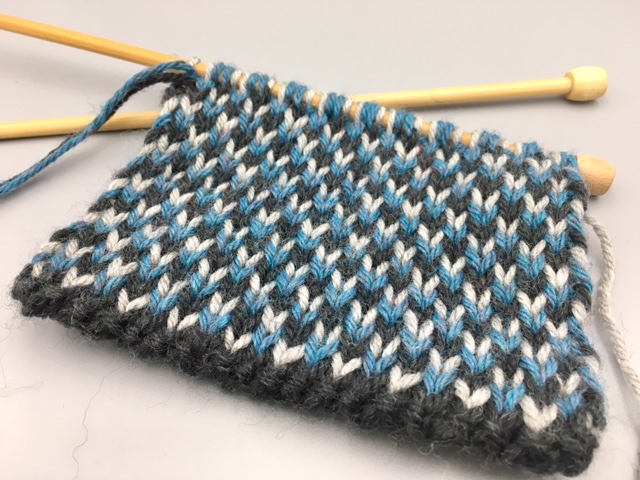
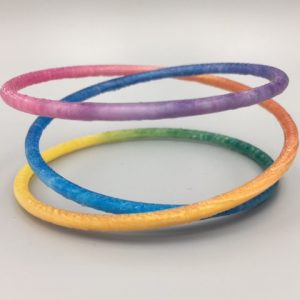
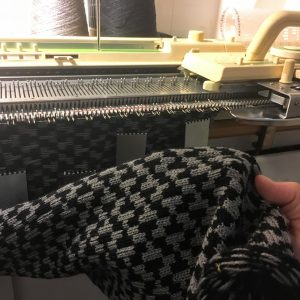
WOW! I’m a fan already! I gave this a test drive and it is as advertised: easy, flat, WONDERFUL! Thinking of design ideas…thank you thank you thank you.